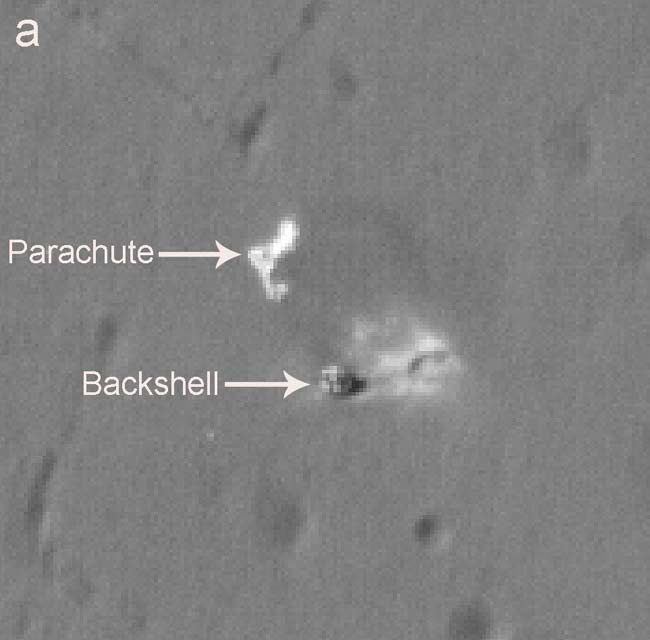Mars Orbiter Spies Rover Landing Site

New imagerytaken by NASA's MarsReconnaissance Orbiter has been released, a sweeping gallery of red planetphotos - including Endurancecrater that NASA's Opportunityrover explored for ten months.
The zoomlens photo album comes courtesy of the Mars Reconnaissance Orbiter's (MRO) HighResolution Science Imaging Experiment (HiRISE).
Imageryreleased today shows the landing site for the Opportunity Mars rover with its parachute restingatop the Martian landscape [image],the spacecraft's heat shield at a different spot [image],and the airbag cushioned lander itself resting inside the floor of a smallimpact feature - later dubbed Eagle Crater [image].
The HiRISEcamera takes images of 3.5-mile-wide (six-kilometer) swaths as the orbiterflies at about 7,800 mph (12,552 kilometers per hour) between 155 and 196 miles(250 to 316 kilometers) above the planet. The camera resolves geologic featuresas small as 40 inches (101 centimeters) across.
Easy-to-findhardware
Thatsharpshooting skill will be put to good use in weeks to come, said AlfredMcEwen of the University of Arizona's Lunar and Planetary Laboratory in Tucson.
Upcomingtargets are "all the easy-to-find hardware on Mars," McEwen noted in a pressstatement. That includes the Spiritrover -- Opportunity's sister ship investigating the ColumbiaHills - as well as the Viking 1and Viking 2 landers that touched down in 1976, and the MarsPathfinder that landed in July 1997.
Get the Space.com Newsletter
Breaking space news, the latest updates on rocket launches, skywatching events and more!
In October,HiRISE was able to spotthe Opportunity rover shortly after the Mars machinery reached the large VictoriaCrater - an exploration site that the robot is presently studying [image].
MRO imageryof Mars released today is the first of what is being billed as "a non-stopflood of incredibly detailed Mars images" that are to be taken during thespacecraft's two-year primary science mission. The orbiter is expected torevolutionize our understanding of the red planet, as well as help discern safesites for future robotic and human missions to Mars.
MRO was launchedin August 2005. After a lengthy period of aerobrakingaround the red planet - a technique used to slow the craft down and enter adesired orbit - the spacecraft began its sciencemapping mission earlier this month.
- NASA Enlists Mars Probe to Search for Missing Craft
- VIDEO: All Eyes on Mars
- IMAGES: Visualizations of Mars
- Complete Coverage: Mars Rovers
- Red Planet Recon: Complete Coverage of NASA's MRO Mission to Mars
- All About Mars
Join our Space Forums to keep talking space on the latest missions, night sky and more! And if you have a news tip, correction or comment, let us know at: community@space.com.

Leonard David is an award-winning space journalist who has been reporting on space activities for more than 50 years. Currently writing as Space.com's Space Insider Columnist among his other projects, Leonard has authored numerous books on space exploration, Mars missions and more, with his latest being "Moon Rush: The New Space Race" published in 2019 by National Geographic. He also wrote "Mars: Our Future on the Red Planet" released in 2016 by National Geographic. Leonard has served as a correspondent for SpaceNews, Scientific American and Aerospace America for the AIAA. He has received many awards, including the first Ordway Award for Sustained Excellence in Spaceflight History in 2015 at the AAS Wernher von Braun Memorial Symposium. You can find out Leonard's latest project at his website and on Twitter.









